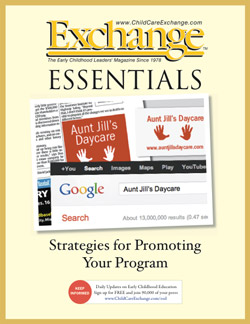ExchangeEveryDay Past Issues
 << Previous Issue
| View Past Issues | | Next Issue >>
<< Previous Issue
| View Past Issues | | Next Issue >> -Henri Matisse
In their article, "Preparing to Evaluate Your Child Care Center's Performance," which is included in the Exchange Essential, Measuring Program Quality and Staff Performance, Cindy Ratekin and Gary Bess outline the following elements that can be measured in a program evaluation:
- Desired outcomes: The desired anticipated change, improvement, or standard of performance that the child care center intends to meet.
- Target population/grouping: The target of change, improvement, or level of analysis that is to be affected.
- Desired change: The level of change quantifiably determined (e.g., percentage of improvement or attainment of a specific level of performance).
- Baseline data: Current information on the child care center in a quantifiably understandable form.
- Timeframe: The period during which change, improvement, or comparison against standard is made.
- Measurement indicator: The method and specific measurement that your child care center will rely upon to determine whether change, improvement, or achievement has been met.
Enter code "Exchange5" when prompted.
 Today only you can purchase the Exchange Essential "Strategies for Promoting Your Program" or any of the 40 other Exchange Essential article collections at a 50% discount!
Today only you can purchase the Exchange Essential "Strategies for Promoting Your Program" or any of the 40 other Exchange Essential article collections at a 50% discount!
Exchange has published over 2,800 articles. We have selected the most popular of these articles and organized them by topic into PDF collections that you can download to your desktop for immediate use. You'll find that Exchange Essentials are the perfect platform for staff development and training sessions that deliver the essential, critical information staff and students need. Enjoy!
View All Titles and Purchase!
Sale ends 5/13/2016 11:59pm PST.
May not be combined with any other offer.
Not valid on bulk purchase discounts.




Comments (2)
Displaying All 2 CommentsUnited States
It is not Early Reading that may be harmful but the TEACHING of Early Reading that may be harmful. Your title is misleading!
Yuba City, CA (California ), United States
My colleague frequently shares your interesting and high quality articles with me. I appreciate your balanced approach and developmentally sensitive information. However, your recent article "Raising Generous Children" was an exception. The article was confusing and certainly as "counter-intuitive" as the concepts it described. The idea that "Cheating was cut in half when instead of, 'Please don't cheat,' participants were told, 'Please don't be a cheater.' " is presented as though the end justifies the means and seems to disregard the high potential for emotional harm that comes with labeling.
The article goes on to describe some of the potential effects by describing the difference between guilt and shame. "Shame is the feeling that I am a bad person, whereas guilt is the feeling that I have done a bad thing. Shame is a negative judgment about the core self, which is devastating....." This paragraph seems to clearly support the concept that shaming a person through the feeling that they are a bad person i.e. a cheater id devastating and may lead to behavioral acting out.
My concern in reading this article is that this information is not clearly presented. As a reader I am left unsure of your position (but hopeful that you are not advocating the labeling of children in an attempt to shape behavior). It seems as though the article needs a closing paragraph to summarize the information and clearly present your position.
If your position is to suggest that labeling of the child instead of the behavior be used as a behavior management technique then a consult with an early childhood mental health professional or highly trained child development staff might be of benefit to the author of this piece. I hope that you will clarify your position in a future column so that children are not hurt by what seems to be your support of a very unhealthy practice.
Post a Comment